MITSUBISHI GRANDIS 2008 Owner's Manual (in English)
Manufacturer: MITSUBISHI, Model Year: 2008, Model line: GRANDIS, Model: MITSUBISHI GRANDIS 2008Pages: 458, PDF Size: 18.52 MB
Page 311 of 458
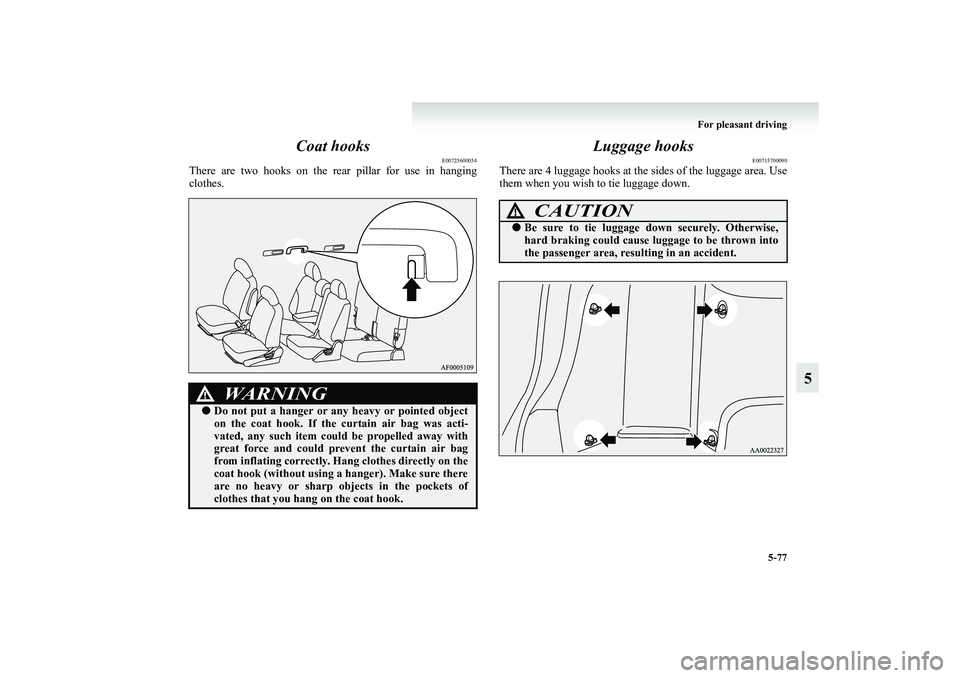
For pleasant driving
5-77
5 Coat hooks
E00725600034
There are two hooks on the rear pillar for use in hanging
clothes.
Luggage hooks
E00715700090
There are 4 luggage hooks at the sides of the luggage area. Use
them when you wish to tie luggage down.
WARNING
!●Do not put a hanger or any heavy or pointed object
on the coat hook. If the curtain air bag was acti-
vated, any such item could be propelled away with
great force and could prevent the curtain air bag
from inflating correctly. Hang clothes directly on the
coat hook (without using a hanger). Make sure there
are no heavy or sharp objects in the pockets of
clothes that you hang on the coat hook.
CAUTION
!●Be sure to tie luggage down securely. Otherwise,
hard braking could cause luggage to be thrown into
the passenger area, resulting in an accident.
BK-XP08E1ENUK.en-uk.book Page 77 Monday, August 13, 2007 2:20 PM
Page 312 of 458
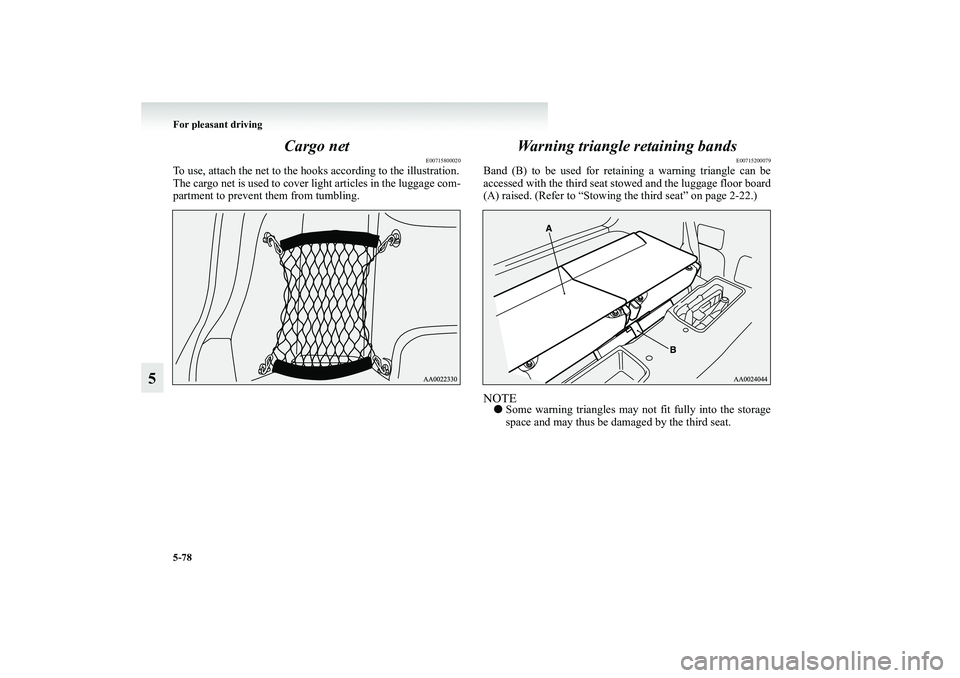
5-78 For pleasant driving
5Cargo net
E00715800020
To use, attach the net to the hooks according to the illustration.
The cargo net is used to cover light articles in the luggage com-
partment to prevent them from tumbling.
Warning triangle retaining bands
E00715200079
Band (B) to be used for retaining a warning triangle can be
accessed with the third seat stowed and the luggage floor board
(A) raised. (Refer to “Stowing the third seat” on page 2-22.)NOTE●Some warning triangles may not fit fully into the storage
space and may thus be damaged by the third seat.
BK-XP08E1ENUK.en-uk.book Page 78 Monday, August 13, 2007 2:20 PM
Page 313 of 458
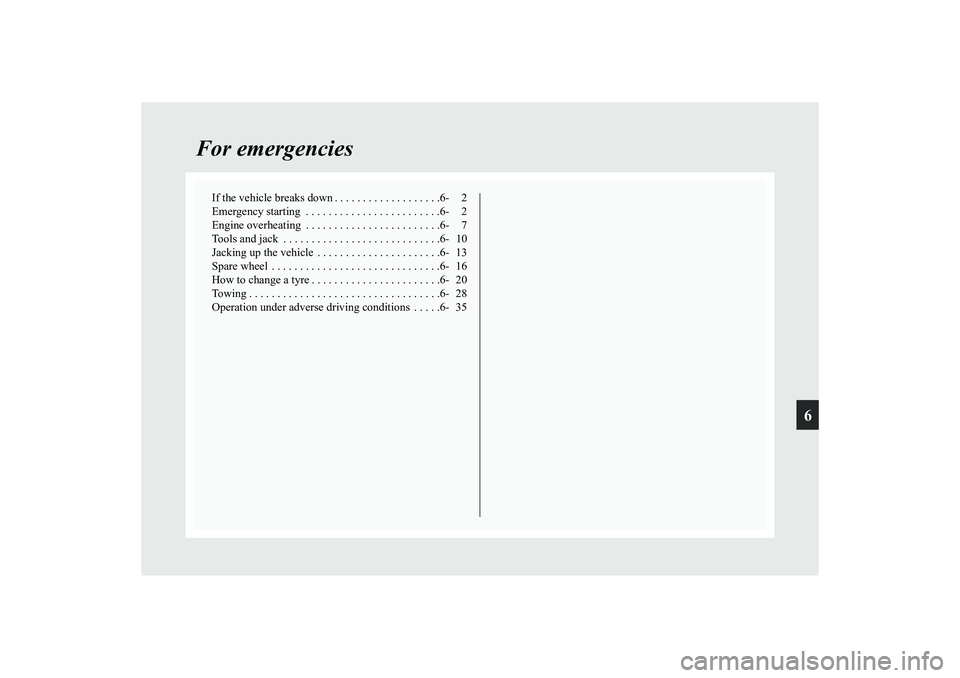
6
For emergencies
If the vehicle breaks down . . . . . . . . . . . . . . . . . . .6- 2
Emergency starting . . . . . . . . . . . . . . . . . . . . . . . .6- 2
Engine overheating . . . . . . . . . . . . . . . . . . . . . . . .6- 7
Tools and jack . . . . . . . . . . . . . . . . . . . . . . . . . . . .6- 10
Jacking up the vehicle . . . . . . . . . . . . . . . . . . . . . .6- 13
Spare wheel . . . . . . . . . . . . . . . . . . . . . . . . . . . . . .6- 16
How to change a tyre . . . . . . . . . . . . . . . . . . . . . . .6- 20
Towing . . . . . . . . . . . . . . . . . . . . . . . . . . . . . . . . . .6- 28
Operation under adverse driving conditions . . . . .6- 35
BK-XP08E1ENUK.en-uk.book Page 1 Monday, August 13, 2007 2:20 PM
Page 314 of 458
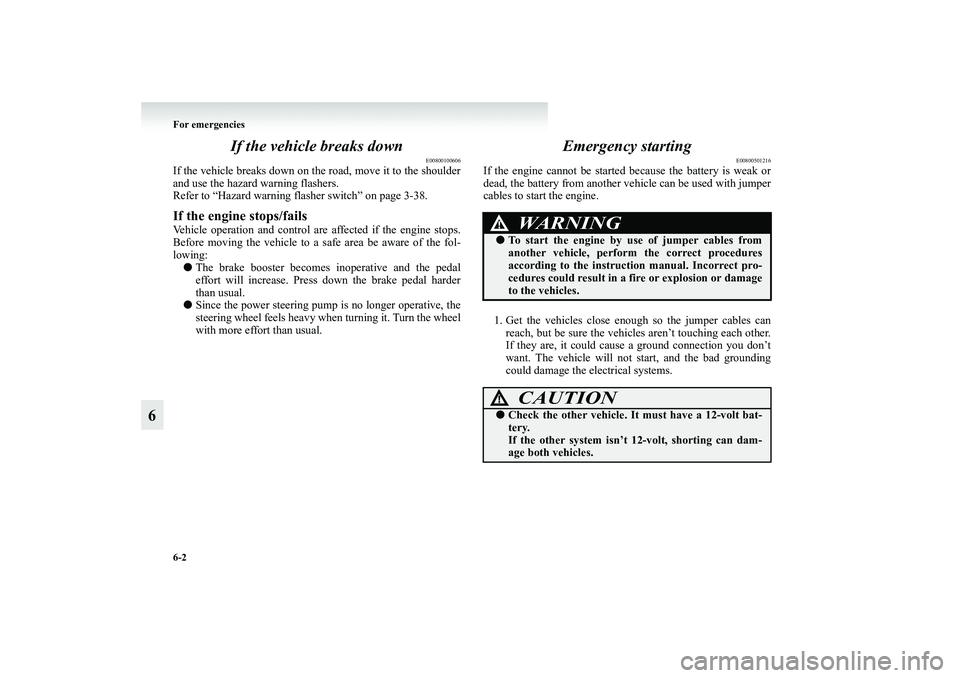
6-2 For emergencies
6If the vehicle breaks down
E00800100606
If the vehicle breaks down on the road, move it to the shoulder
and use the hazard warning flashers.
Refer to “Hazard warning flasher switch” on page 3-38.If the engine stops/failsVehicle operation and control are affected if the engine stops.
Before moving the vehicle to a safe area be aware of the fol-
lowing:
●The brake booster becomes inoperative and the pedal
effort will increase. Press down the brake pedal harder
than usual.
●Since the power steering pump is no longer operative, the
steering wheel feels heavy when turning it. Turn the wheel
with more effort than usual.
Emergency starting
E00800501216
If the engine cannot be started because the battery is weak or
dead, the battery from another vehicle can be used with jumper
cables to start the engine.
1. Get the vehicles close enough so the jumper cables can
reach, but be sure the vehicles aren’t touching each other.
If they are, it could cause a ground connection you don’t
want. The vehicle will not start, and the bad grounding
could damage the electrical systems.
WARNING
!●To start the engine by use of jumper cables from
another vehicle, perform the correct procedures
according to the instruction manual. Incorrect pro-
cedures could result in a fire or explosion or damage
to the vehicles.
CAUTION
!●Check the other vehicle. It must have a 12-volt bat-
tery.
If the other system isn’t 12-volt, shorting can dam-
age both vehicles.
BK-XP08E1ENUK.en-uk.book Page 2 Monday, August 13, 2007 2:20 PM
Page 315 of 458
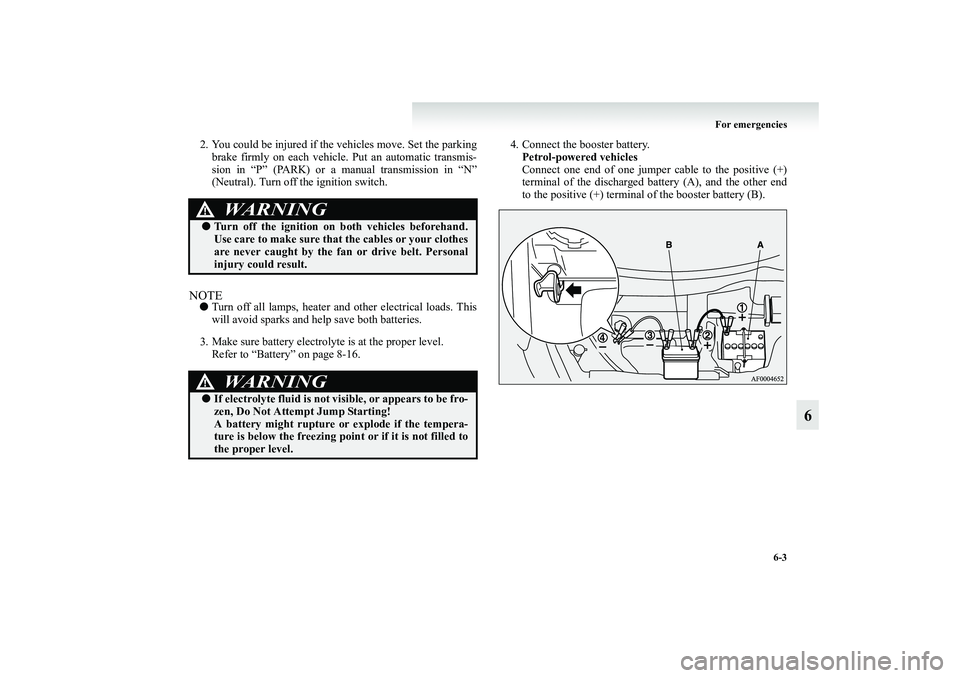
For emergencies
6-3
6
2. You could be injured if the vehicles move. Set the parking
brake firmly on each vehicle. Put an automatic transmis-
sion in “P” (PARK) or a manual transmission in “N”
(Neutral). Turn off the ignition switch.NOTE●Turn off all lamps, heater and other electrical loads. This
will avoid sparks and help save both batteries.
3. Make sure battery electrolyte is at the proper level.
Refer to “Battery” on page 8-16.4. Connect the booster battery.
Petrol-powered vehicles
Connect one end of one jumper cable to the positive (+)
terminal of the discharged battery (A), and the other end
to the positive (+) terminal of the booster battery (B).
WARNING
!●Turn off the ignition on both vehicles beforehand.
Use care to make sure that the cables or your clothes
are never caught by the fan or drive belt. Personal
injury could result.
WARNING
!●If electrolyte fluid is not visible, or appears to be fro-
zen, Do Not Attempt Jump Starting!
A battery might rupture or explode if the tempera-
ture is below the freezing point or if it is not filled to
the proper level.
BK-XP08E1ENUK.en-uk.book Page 3 Monday, August 13, 2007 2:20 PM
Page 316 of 458
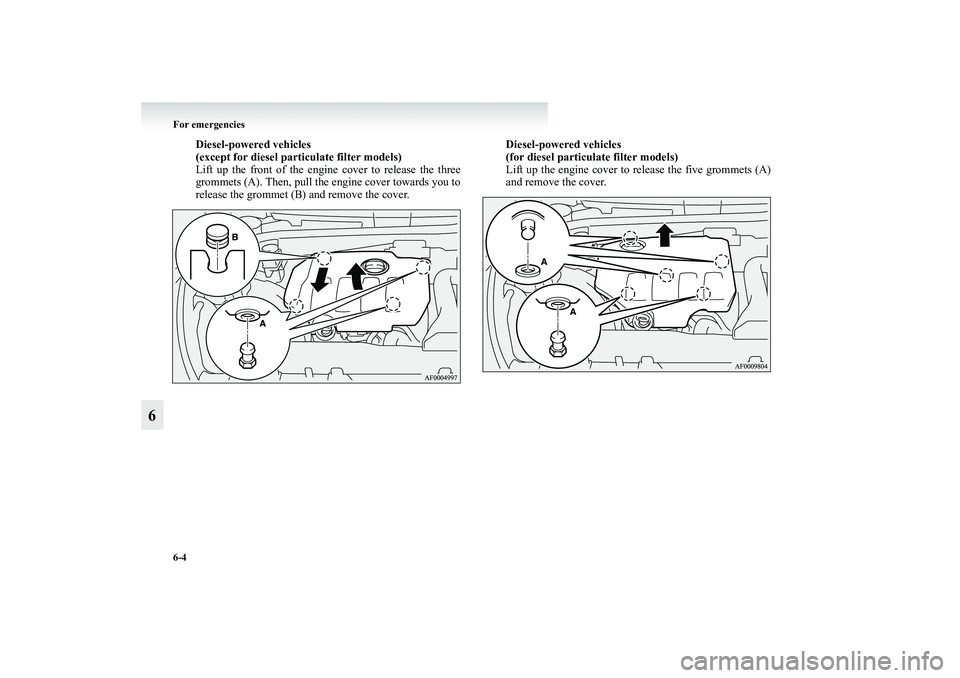
6-4 For emergencies
6
Diesel-powered vehicles
(except for diesel particulate filter models)
Lift up the front of the engine cover to release the three
grommets (A). Then, pull the engine cover towards you to
release the grommet (B) and remove the cover.Diesel-powered vehicles
(for diesel particulate filter models)
Lift up the engine cover to release the five grommets (A)
and remove the cover.
BK-XP08E1ENUK.en-uk.book Page 4 Monday, August 13, 2007 2:20 PM
Page 317 of 458
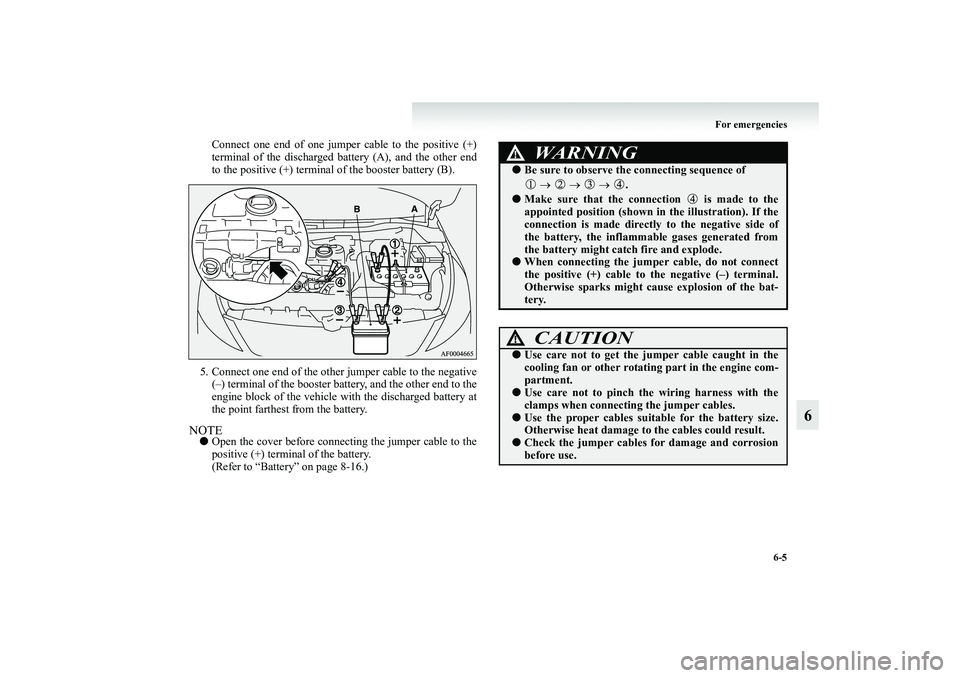
For emergencies
6-5
6
Connect one end of one jumper cable to the positive (+)
terminal of the discharged battery (A), and the other end
to the positive (+) terminal of the booster battery (B).
5. Connect one end of the other jumper cable to the negative
(–) terminal of the booster battery, and the other end to the
engine block of the vehicle with the discharged battery at
the point farthest from the battery.
NOTE●Open the cover before connecting the jumper cable to the
positive (+) terminal of the battery.
(Refer to “Battery” on page 8-16.)
WARNING
!●Be sure to observe the connecting sequence of
→ → → .●Make sure that the connection is made to the
appointed position (shown in the illustration). If the
connection is made directly to the negative side of
the battery, the inflammable gases generated from
the battery might catch fire and explode.●When connecting the jumper cable, do not connect
the positive (+) cable to the negative (–) terminal.
Otherwise sparks might cause explosion of the bat-
tery.
CAUTION
!●Use care not to get the jumper cable caught in the
cooling fan or other rotating part in the engine com-
partment.●Use care not to pinch the wiring harness with the
clamps when connecting the jumper cables.●Use the proper cables suitable for the battery size.
Otherwise heat damage to the cables could result.●Check the jumper cables for damage and corrosion
before use.
BK-XP08E1ENUK.en-uk.book Page 5 Monday, August 13, 2007 2:20 PM
Page 318 of 458
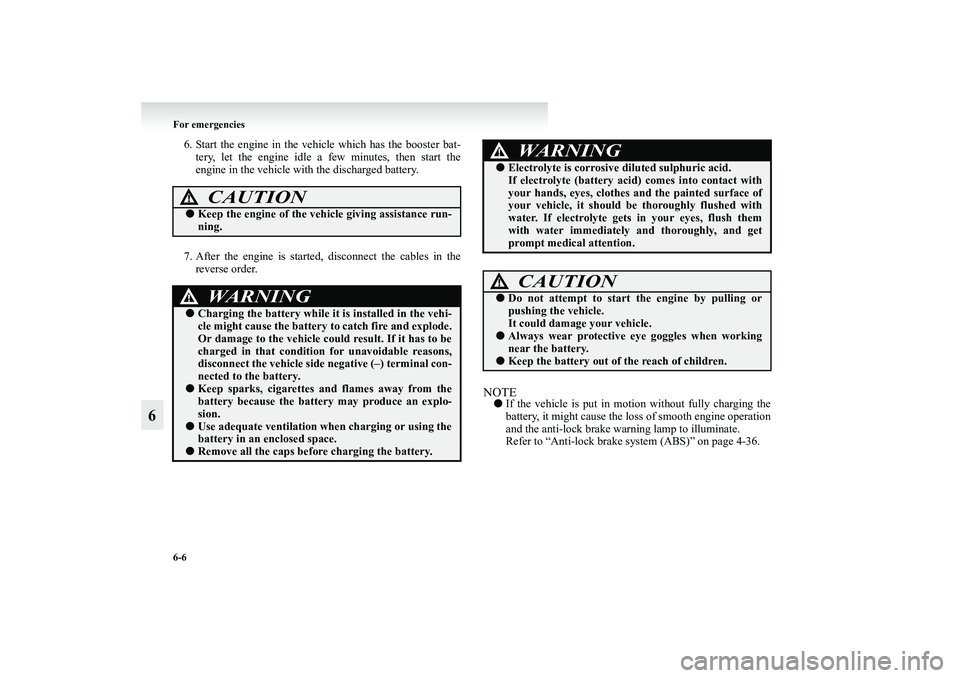
6-6 For emergencies
6
6. Start the engine in the vehicle which has the booster bat-
tery, let the engine idle a few minutes, then start the
engine in the vehicle with the discharged battery.
7. After the engine is started, disconnect the cables in the
reverse order.
NOTE●If the vehicle is put in motion without fully charging the
battery, it might cause the loss of smooth engine operation
and the anti-lock brake warning lamp to illuminate.
Refer to “Anti-lock brake system (ABS)” on page 4-36.
CAUTION
!●Keep the engine of the vehicle giving assistance run-
ning.
WARNING
!●Charging the battery while it is installed in the vehi-
cle might cause the battery to catch fire and explode.
Or damage to the vehicle could result. If it has to be
charged in that condition for unavoidable reasons,
disconnect the vehicle side negative (–) terminal con-
nected to the battery.●Keep sparks, cigarettes and flames away from the
battery because the battery may produce an explo-
sion.●Use adequate ventilation when charging or using the
battery in an enclosed space.●Remove all the caps before charging the battery.
●Electrolyte is corrosive diluted sulphuric acid.
If electrolyte (battery acid) comes into contact with
your hands, eyes, clothes and the painted surface of
your vehicle, it should be thoroughly flushed with
water. If electrolyte gets in your eyes, flush them
with water immediately and thoroughly, and get
prompt medical attention.
CAUTION
!●Do not attempt to start the engine by pulling or
pushing the vehicle.
It could damage your vehicle.●Always wear protective eye goggles when working
near the battery.●Keep the battery out of the reach of children.
WARNING
!
BK-XP08E1ENUK.en-uk.book Page 6 Monday, August 13, 2007 2:20 PM
Page 319 of 458
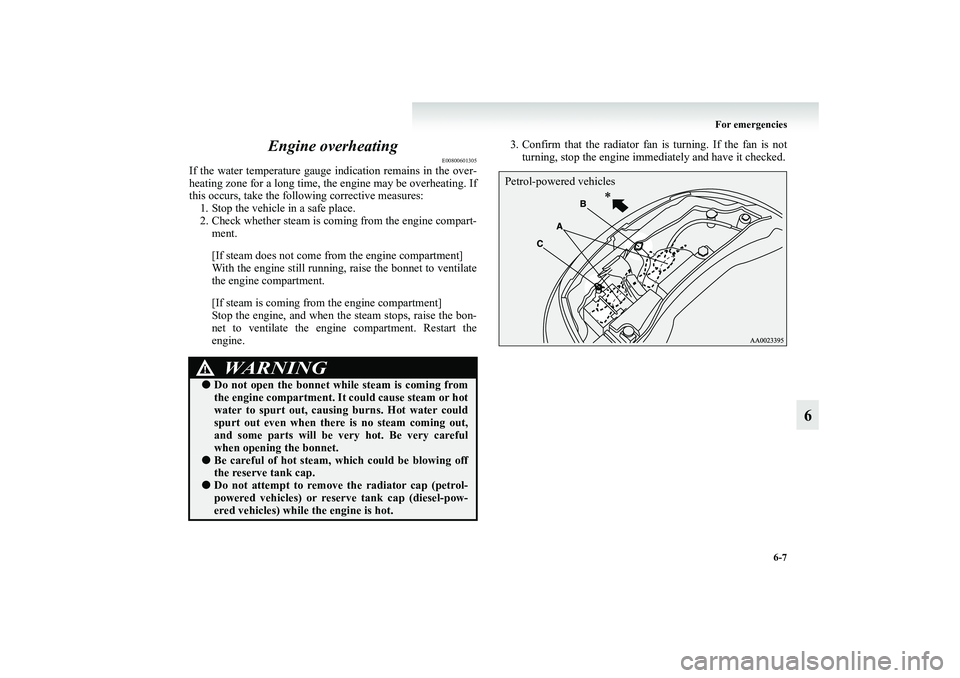
For emergencies
6-7
6 Engine overheating
E00800601305
If the water temperature gauge indication remains in the over-
heating zone for a long time, the engine may be overheating. If
this occurs, take the following corrective measures:
1. Stop the vehicle in a safe place.
2. Check whether steam is coming from the engine compart-
ment.
[If steam does not come from the engine compartment]
With the engine still running, raise the bonnet to ventilate
the engine compartment.
[If steam is coming from the engine compartment]
Stop the engine, and when the steam stops, raise the bon-
net to ventilate the engine compartment. Restart the
engine.3. Confirm that the radiator fan is turning. If the fan is not
turning, stop the engine immediately and have it checked.
WARNING
!●Do not open the bonnet while steam is coming from
the engine compartment. It could cause steam or hot
water to spurt out, causing burns. Hot water could
spurt out even when there is no steam coming out,
and some parts will be very hot. Be very careful
when opening the bonnet.●Be careful of hot steam, which could be blowing off
the reserve tank cap.●Do not attempt to remove the radiator cap (petrol-
powered vehicles) or reserve tank cap (diesel-pow-
ered vehicles) while the engine is hot.
Petrol-powered vehicles
BK-XP08E1ENUK.en-uk.book Page 7 Monday, August 13, 2007 2:20 PM
Page 320 of 458
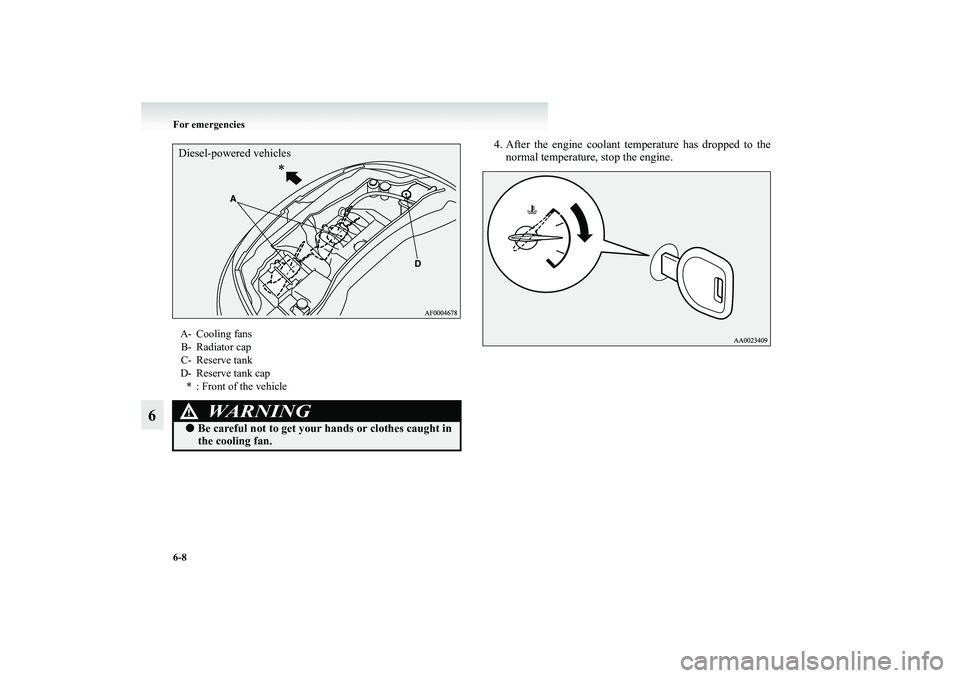
6-8 For emergencies
6
4. After the engine coolant temperature has dropped to the
normal temperature, stop the engine.
A- Cooling fans
B- Radiator cap
C- Reserve tank
D- Reserve tank cap
* : Front of the vehicle
WARNING
!●Be careful not to get your hands or clothes caught in
the cooling fan.Diesel-powered vehiclesBK-XP08E1ENUK.en-uk.book Page 8 Monday, August 13, 2007 2:20 PM